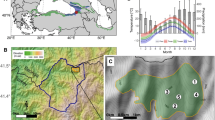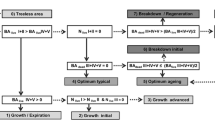Abstract
Forest stands are constantly being impacted by disturbances. When the disturbances are “lethal”, growing space is released which can then be occupied by the remaining trees or by new vegetation. Lethal disturbances can be either natural (e.g., fire or wind) or anthropogenic (e.g., harvesting or herbicides) events where trees are killed. The structure of the stand at the time of the disturbance as well as the type, intensity, and magnitude of the disturbance will dictate the future development of the stand. The mechanism driving development is simply change in competitive advantage of the surviving and the regenerating individuals. Just as development after a particular disturbance in single-species stands can be predicted quite well, development of mixed-species stands is far from unpredictable randomness, but is complicated by the species differences.
Access this chapter
Tax calculation will be finalised at checkout
Purchases are for personal use only
Preview
Unable to display preview. Download preview PDF.
Similar content being viewed by others
Literature
Davis, W. C. 1989. Role of released advance growth in the development of spruce-fir stands in eastern Maine. Unpublished doctoral dissertation, Yale University, New Haven, CT. 150 pp.
Kelty, M. J. 1986. Development patterns in two hemlock-hardwood stands in southern New England.Canadian Journal of Forest Research 16: 885–891.
Kittredge, D. B. 1988. The influence of species composition on the growth of individual red oaks in mixed species stands in southern New England. Canadianfournalof Forest Research 18: 1550: 1555.
Larson, B.C. 1986. Development and growth of even-age stands of Douglas-fir and grand fir. Canadian Journal of Forest Research 16: 367–372.
Larson, B. C. and C. D. Oliver. 1982. Forest dynamics and fuelwood supply of the Stehekin Valley, Washington, in Ecological Research in National Parks of the Pacific Northwest Oregon State University Forest Research Laboratory Publication, Corvallis, Oregon, pp 127–134.
Marks, P. L. 1974. The role of pin cherry (Prunus pensylvanica) in the maintenance of stability in northern hardwood ecosystems. Ecological Monongraphs 44: 73–88.
O’Hara, K. L. 1986. Development pattems of residual oaks and oak and yellow-poplar regeneration after release in upland hardwood stands. Southern Journal of Applied Forestry 10: 244–248.
Oliver, C. D. 1978. Development of northern red oak in mixed-species stands in central New England,Yale University School of Forestry and Environmental Studies Bulletin No. 91, 63 pp.
Oliver, C. D. 1981. Forest development in North America following major disturbances. Forest Ecology and Management 3: 153–168.
Oliver, C. D., W. K. Clatterbuck and E. C. Burkhardt. 1990. Spacing and stratification patterns of cherrybark oak and American sycamore in mixed, even-aged stands in the southeastern United States. Forest Ecology and Management 31: 67–79.
Stubblefield, G. W. 1978. Reconstruction of a red alder Douglas-fir western hemlock westem red cedar mixed stand and its biological and silvicultural implications. Unpublished Master of Science thesis, College of Forest Resources, University of Washington, Seattle, Washington. 141 pp.
Wierman C. A. and C. D. Oliver. 1979. Crown stratification by species in even-aged mixed stands of Douglas-fir western hemlock. Canadian Journal of Forest Research 9: 1–9.
Editor information
Editors and Affiliations
Rights and permissions
Copyright information
© 1992 Springer Science+Business Media Dordrecht
About this chapter
Cite this chapter
Larson, B.C. (1992). Pathways of development in mixed-species stands. In: Kelty, M.J., Larson, B.C., Oliver, C.D. (eds) The Ecology and Silviculture of Mixed-Species Forests. Forestry Sciences, vol 40. Springer, Dordrecht. https://doi.org/10.1007/978-94-015-8052-6_1
Download citation
DOI: https://doi.org/10.1007/978-94-015-8052-6_1
Publisher Name: Springer, Dordrecht
Print ISBN: 978-90-481-4135-7
Online ISBN: 978-94-015-8052-6
eBook Packages: Springer Book Archive




